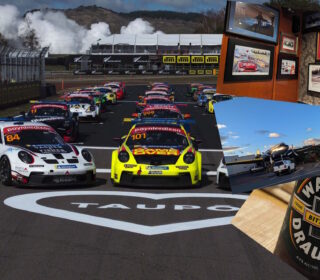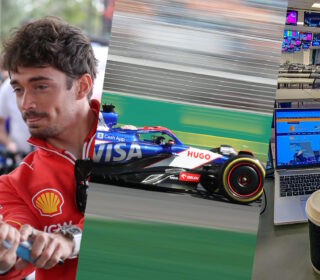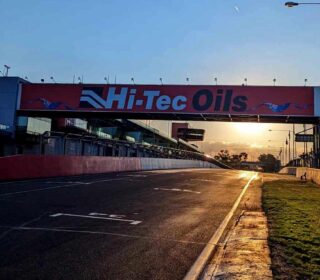Le Mans Diary #4 – Le Museum

THINGS are getting busy at Le Mans as we count down to the commencement of track activities, officially, on Wednesday local time.
The vibe is building and after what must have been 70,000 people attending the test day on Sunday even more people are rolling into the circuit now.
Tuesday is packed – there’s no circuit activity however the official pit stop competition in pit lane keeps fans engaged. In the enormous ‘Village’ activation area adjacent to pit lane, every retailer is open and doing a brisk trade.
The official stores are busy and relaxed and the gear is really good quality stuff. A polo shirt is AUD $75 which is actually reasonable, and hats are AUD$40 – which makes the $100 for a Formula 1 team cap at the Australian Grand Prix seem like utter daylight robbery, which of course, it is.
The Ferrari store, meanwhile, has a lengthy line, a bouncer and a long, airport security line zig-zagging up to the main counter.
Only there may you make your selection of clothes, none of which cost $80.
Still, each to their own and Ferrari look to make plenty of cash from their merchandise operations this year, at a race where they have a team that is actually competitive.

The big lure for today, however, was the Museum, located outside the main gate of the circuit in a massive structure – it’s on drivers’ left as they head up the hill through Turn 1, behind the grandstands.
Inside, the ACO has curated a display of remarkable depth and breadth, showcasing the 100 years they have been racing here. Broken into areas defined by each decade the cars date back as far as the early 1920s and right through to the Toyota that won last year.
It starts with a remarkable circular room lined by glass display cases featuring 1/43 scale replicas of almost every car that has raced in the Le Mans 24 Hours.
And when we say almost every car – we mean it. Remarkably, the collection is missing less than 30 cars in total – about half of those to come from the more recent years.
It’s a remarkable trek through the history of the race in miniature scale and the attention to detail is incredible, class winners elevated on a mini podium for each year. It’s breathtaking.
It’s much the same for the 1:1 scale cars too.
There are more than 80 assembled, of which more than 50 are genuine, Le Mans 24 Hour winners.
Perish the thought of what they are insured for.
There’s crazy French specials, stunning Alfa’s the Le Monstre Cadillac from the 1950s and an utterly biblical pair of Jag D-Types – conservative value $40m – sitting not far from a Ferrari 250GTO, which is probably worth that on its own.
Geoff Brabham’s winning Peugeot is there, not far from the screaming Mazda 787.
The lineup of Rothmans Porsches look merely standard by comparison to some of the stuff here though, of course, they are not.
As the pathway becomes more modern, the cars become less well presented, though not in a bad way; the power of manufacturer-backed motorsport is such that should you win Le Mans, it’s perfectly okay to retire the car on the spot and ensure it remains in as-raced conditions.
As such, just about every Audi, Peugeot, Porsche and Toyota to have won here for the last two decades are presented bug splattered, filthy, dirty and dusty and stickers sandblasted off.
Tellingly, the later cars are illuminated by a red LED light – their Hybrid charge still present..
The museum is spectacular. There’s not much in the way of memorabilia – Bathurst National Motor Racing Museum has much more – but the sheer shock of seeing so many historically remarkable cars in the one place; some of them separated by little more than six inches and some bunting, makes his a memorable visit indeed.
Stay tuned – the full gallery is to follow soon…
**
MY OLD MATE Matt Campbell missed out on a drive this year which means he’s on garage tour duties when fellow Aussies come knocking.
I’ll delve into the inner workings of the 962 and the garage itself later, but the setup is remarkable.
Each driver has a separate drivers’ room with en suite, bed and aircon for their escape mid race.
Each car has three full sets of bodywork for use should they need it.
Porsche are always pretty good at presentation but the Penske factory has raised things even further.
There’s soft-feel rubber flooring in each Garage which is sturdy enough to carry the car on the jacks, but soft enough to give the hard working mechanics a break on their feet for the 24-hour race itself.
The doors to cupboards holding the setup gear within the temporary walling on the inside of the garage feature soft-close mechanisms, meaning they never slam shut.
The little stickers with the initials for each crewmember on storage racks out the back of the main garages are not only in the Penske font, but in the Penske font in Chrome vinyl, too. Because of course they are.
There’s complete gearbox and rear end assemblies ready to go should there need to be a gearbox change mid race or session, meanwhile the specialist Hybrid setup next door is roped off to public access given the 50KW Hybrid batteries located within.
The steering wheel, made by Cosworth but customised by the team, is a work of genius. There are four toggle switches, four rotary wheels and a host of buttons, meaning the drivers have more than 120 separate control settings they can potentially manage throughout.
It is every bit the setup of a Formula One team, only bigger and more impressive given the unique demands required by long-distance endurance racing.
My favourite piece among it all is the little perch between the front wheels of the #6 and #7 cars, where one man sits.
It turns out his role is vital – he is the font of all information when it comes to rules and regulations (this is France, there are many and they are complicated), so he gets a premium position next to the full-time WEC cars.
And yes, the Captain will be here. He has his own space upstairs, a direct line to each of the three teams and is expected to play a role in the management of the race as he does with his IndyCar and NASCAR teams.
It would not be surprising if this is the year where he finally adds Le Mans to his full house of other major motorsport trophies.
**
LATER we walk through the Sotheby’s auction area, which could be a Le Mans Museum in its own right.
There’s some incredible stuff in there prepped for a big sale that will take place on Friday, when the only track action is the Road to Le Mans sprint race.
You enter with a GT1-spec Dodge Viper, because of course you do.
But there’s Jaguar XJ220s, a Mazda R90CK, Spykers and a dummy Porsche 919 Hybrid attractively guide priced at EUR$85,000-$120,000 (AUD $120-$190K).
The stars of the show, however, are two cars at the very end, elevated up on stands.
One is a 1991 Silk Cut Jaguar XJR-12 LM, driven by Derek Warwick, Andy Wallace and Jan Nielsen that finished fourth that year. With it’s 7.4 Litre V12 in place, it’s resplendent in its Purple and with its almost totally enclosed rear wheels.
It’s expected to go for between AUD$3.2-$4.8 million dollars.
But that’s not all.
Next to the Jaaag, is the famous livery of a Rothmans Porsche.
This is a 1985 Rothmans Porsche 962C, driven by no fewer than eight Le Mans winners across its life, including Derek Bell, Al Holbert, Jacky Ickx, Klaus Ludwig, Jochen Mass, Vern Schuppan, Hans Stuck, and John Winter.
It’s one of the most-raced 962s ever, scored pole for the 1986 race and finished 5th in 1988.
It runs, has been at Goodwood and by the way is the first factory Rothmans Porsche to be offered for sale or at auction.
I want it, quite badly. It even comes with the spare high-downforce rear aero package as an added bonus – value!
Sadly I don’t have the AUD$10-$15m it’s expected to be sold for. Which is sad.
Still, there’s cars on track tomorrow – finally – which I suspect will make me feel much better.














